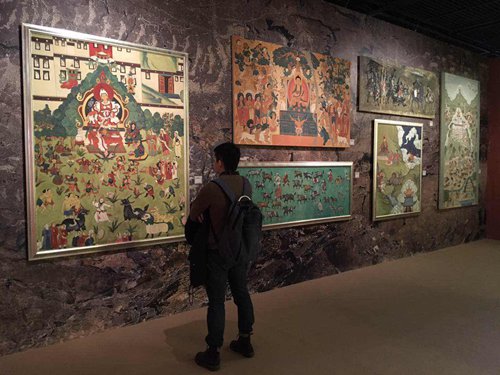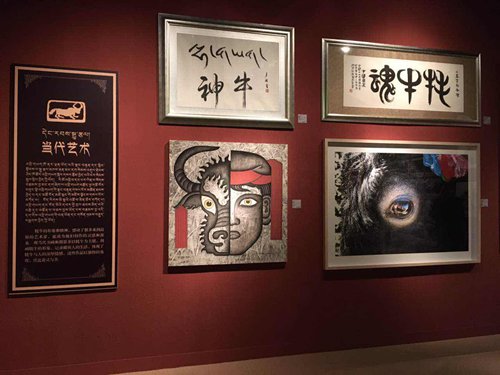

Visitors take in the Yaks Walk into Beijing: A Cultural Exhibition on the Plateau Yak exhibition at the Capital Museum in Beijing on December 21. (Photo: Wei Xi/GT)
In the information age today, Tibet remains a mysterious place even for many Chinese people. Seeking to better introduce Tibetan culture to the curious, exhibition Yaks Walk into Beijing: A Cultural Exhibition on the Plateau Yak recently opened at the Capital Museum.
Yak fossils dating from 45,000 years ago, cliff paintings from 4,000 years ago and various painted thangka and khata silk scarves featuring yaks designs that were made hundreds of years ago - more than 500 yak-related exhibits are now on display at the museum.
"Yaks are indivisible from Tibetan people," Tashi Phuntsok, an interpreter at the exhibition, told the Global Times on December 21.
"But because they are so commonly seen in people's lives, they have long been neglected, even among Tibetans."
Yaks have been an important part of the lives of Tibetan people for thousands of years. They not only serve as a mode of transportation but also provide daily commodities. Yaks can be milked, their hair is weaved into tents, their droppings are used as fuel for cooking and heating homes, and back in the days before modern vehicles, yaks carried bags of salt for Tibetan families.
"Yaks have been a lifelong friend to Tibetans. When a yak is born, we give it a name. Children are often given a yak as a companion during childhood," Tashi Phuntsok explained, adding that even though sometimes they are eaten when times get tough, to kill a yak is a very sad thing for a Tibetan to bear.
Often the skull of a yak is placed on a pile of Mani stones, stones inscribed with a six syllable mantra, as a way to show respect for life, give thanks to the yak and ease the yak's spirit into its next life. Skulls are also placed on top of the front door or the wall of the main hall in a Tibetan home, as a form of blessing.
"Yaks are a reflection of Tibetan people's lives and culture," Tashi Phuntsok noted.
The items on display are on loan from the Yak Museum in Lhasa, capital of Southwest China's Tibet Autonomous Region. Built in 2014, the museum is the first in the world devoted entirely to the yak. According to Nyima Tsering, a senior staff member at the Yak Museum, the idea for the museum came from Wu Yuchu, a former government official who had worked in Tibet for 18 years.
Nyima Tsering told the Global Times that if the exhibition is successful, the museum will consider bringing it to other museums around China.
"I've never been to Tibet. I want to have some understanding of it since I plan to go there one day when my daughter gets older," a middle-aged mother surnamed Yang who had brought her 6-year-old daughter to the exhibition told the Global Times on December 21.
"There is no better place than an exhibition like this for children on smoggy winter days," she noted, commenting on the thick haze that was covering all of North China that day.
"I heard about the exhibition from a colleague," said 54-year-old Guan. "I've been to Tibet once and I knew yaks were special there, but I didn't pay that much attention to them before."
The exhibition is scheduled to come to an end on March 15, 2017.


















































